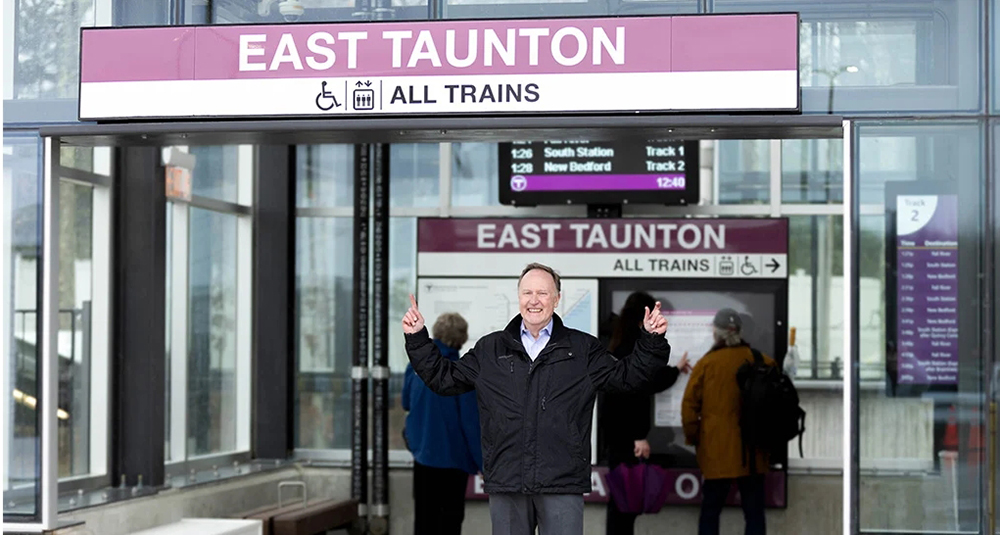News:
Spotlight Content
Posted: June 10, 2009
City of Taunton prepares for its economic future with additional industrial zoned property
Looking forward to the eventual economic rebound, the City of Taunton elected officials took steps to be ready with additional industrial zoned property and buildings for existing companies and new companies to the greater Taunton area. First the Planning Board and then the City Council voted unanimously to support Mayor Charles Crowley's petition to expand the industrial zone adjacent to the highly successful Myles Standish Industrial Park to 200 acres. This action was possible once the former Paul A. Dever State School campus redevelopment legislation sponsored by Senator Mark Pacheco and Representatives James Fagan, Patricia Haddad, and Stephen Canassa was passed and signed in December by Governor Patrick. The legislation included the future creation of a Life Science Education and Training Center for the companies in the Myles Standish Industrial Park and throughout the I-495 South region. Program activities at the 90-acre Dever campus were reduced over time with the final closure in early 2003. Since then the City of Taunton's Office of Economic and Community Development has been working with the Taunton Development Corporation to plan for redevelopment of the Dever campus as an expansion area for MSIP and now for the Life Science Center Campus The overall campus has over 40 obsolete buildings most of which will require demolition and remediation, though a few in the core campus may be able to be rehabbed into classroom or lab facilities for the proposed training center. There are also miles of obsolete utilities (some contained in service tunnels through the campus) and the former heat and power plant that will complicate the redevelopment plan.
In order to properly assess the feasibility and costs of redevelopment, the OECD and the TDC worked with the Southeastern Regional Planning and Economic Development District to obtain a federal Economic Development Administration $100,000 planning grant and then selected the BSC Group to carry out the study. Now in final rewrite to include the newly approved area and rezoning, the study is positive though cautious about the redevelopment of the state school property to provide for the industrial park expansion and proposed education and training center overcoming the daunting demolition and remediation costs. The City of Taunton's long history of forging and maintaining public/private partnerships will be even more important now for this project. The good news is that in spite of the current economic downturn, several current industrial park abutters and tenants have expressed interest in the new expansion area. It is projected that the new expansion area will provide close to 2 million s/f of new or renovated buildings, create 2,500 new jobs, and generate $1.8 million in new property taxes in addition to improved water and sewer services for North Taunton. Open space protection and new recreation areas both passive and active have been included in the Life Science Training and Education Center area. Currently one of the largest industrial parks in Southern New England by building square footage at 5.8 million s/f the Myles Standish Industrial Park has over 100 companies with 7,400 employees, but its vacancy which last year was less than 3% has started to increase.
The TDC's new 350-acre Liberty and Union Industrial Park at the junction of Rtes. 24 and 140 has provided the city with new growth the past few years but is slowly selling out its available building sites. There is however available space in three modern industrial multi-tenant projects: the Revolutionary Way Commerce Center, the Crossroads Commerce Center, and the adjacent Liberty and Union Industrial Business Center. The remaining lots with full city services available can accommodate buildings from 5,000 to 600,000 s/f and are ready to go for construction in 2009. The largest lot of 46 acres has been designated by the state as a Priority Development Site and is on CSX main line with five days a week freight rail service.
Myles Standish Industrial Park lies between the metropolitan areas of Boston and Providence, providing quick access to Logan International and T. F. Green airports. It is directly accessible with its own exit ramp off Rte. 495, just two miles from Rte. 24. It is also just 10 minutes from I-95 and 30 minutes from the I-90/Mass Tpke. It is within 20 miles of deep water ports and has rail connections on the main CSX line in southeastern Massachusetts.
Liberty and Union Industrial Park on the southeast side of Taunton offers direct access to Rte. 24/140 and is 20-30 minutes from the labor rich cities of Brockton, New Bedford, and Fall River.
Convenient location, pricing, low energy costs, workforce availability and 2.5 million populations within 25 mile radius makes Myles Standish and the Liberty and Union Industrial Parks attractive to a broad spectrum of local, national and global tenants.
With the expansion of these priority industrial development areas in East and North Taunton, the Taunton Industrial Development Commission has been able to support commercial and multi-use development, as well as open space conservation and recreational use in older industrial areas of the city. For instance, two historic mills on the Taunton River have been added to the Weir Village business district and are being developed for multi-use. The former 120,000 s/f Robertson Curtain Mill redeveloped by the Weir Corporation is now an award winning fully occupied beautiful 64-unit large, loft style apartment building with 20,000 s/f of commercial space on the first floor on a bend of the Taunton River and within walking distance of the Weir Village Center. Downriver on the other side of the village, the City of Taunton is taking down the majority of the 200,000 s/f former Glenwood Range/F. B. Rogers Silver mill to open the area to the newly designated National Wild and Scenic Taunton River and make room for additional housing. This project is across from the highly successful BandstandLive.com music studios in a former industrial complex, which now houses a dance studio, an indoor skateboard park, and other recreational uses. North of downtown in the Whittenton neighborhood, the owner of the historic Whittenton Mill Complex received a zoning change to residential and business for a multi-use redevelopment of the 40-acre 500,000 s/f property in to commercial, recreational, and housing (both condominiums and apartments) in addition to the existing light industrial use.
Priority commercial development areas have been created within or adjacent to former industrial property, serving often as transition buffer from office or residential zones to newly expanded industrial areas. At the Rtes. 140/24 interchange the 1.2 million s/f Silver City Galleria regional mall and the 600,000 s/f Taunton Depot Plaza and at the I-495/Bay St. across from the entrance of the Myles Standish Industrial Park the newly developing Northwoods Crossing Plaza are providing new investment, taxes, jobs, and services to employees and residents of greater Taunton. Efforts to avoid mall sprawl over the past 15 years have resulted in higher quality plazas and establishments today in these areas.
Taunton's historic central business district, the downtown, and our historic neighborhood centers continue to benefit from the re-energized Taunton Redevelopment Authority which is working on a revised urban renewal plan incorporating current new housing and commercial projects as well as Taunton's new $70 million District Courthouse project currently under construction and plan to take advantage of the state and federal programs on urban centers and brownfield redevelopment including the recent Gateway Cities Plus grant which has funded the current Downtown Study led by the Neighborhood Corporation (formerly the Weir Corp.) in cooperation with the OECD office and the Heart of Taunton.
We are encouraged that the Patrick/Murray administration continues to embrace the importance of priority development areas in terms of jobs created and new investments providing taxes and infrastructure improvements critical to sustainable development. Diversity of development opportunities remain the key to the economic well being of most communities.
Richard Shafer is the economic and industrial development director in the City of Taunton Office of Economic and Community Development.
Tags:
Spotlight Content
MORE FROM Spotlight Content
Check out the New England Real Estate Journal's 2025 Fall Preview Spotlight
NEREJ’s Fall Preview is Out Now!
Explore our Fall Preview Spotlight, featuring exclusive Q&As with leading commercial real estate professionals and in-depth byline articles on today’s most relevant market topics. Gain insight into the trends, challenges, and opportunities shaping New England’s commercial real estate landscape this fall.
Explore our Fall Preview Spotlight, featuring exclusive Q&As with leading commercial real estate professionals and in-depth byline articles on today’s most relevant market topics. Gain insight into the trends, challenges, and opportunities shaping New England’s commercial real estate landscape this fall.

Quick Hits
Columns and Thought Leadership

How long should I hold a property for it to qualify as an investment property in connection with a 1031 tax-deferred exchange? - by Brendan Greene and Mark McCue
Internal Revenue Code (IRC) Section 1031 provides “No gain or loss shall be recognized on the exchange of property held for productive use in a trade or business or for investment if such property is exchanged solely for property of like kind which is to be held

Shallow-bay wins on 495/128: A renewal-driven market with a thin pipeline - by Nate Nickerson
The Boston industrial market entered mid-2025 in a bifurcated state. Large-block vacancy remains elevated, while shallow-bay along the 495/128 corridor continues to prove resilient. Fieldstone’s focus on this geography positions us squarely in the middle of a renewal-driven, supply-constrained

How do we manage our businesses in a climate of uncertainty? - by David O'Sullivan
These are uncertain times for the home building industry. We have the threat of tariffs mixed with high interest rates and lenders nervous about the market. Every professional, whether builder, broker, or architect, asks themselves, how do we manage our business in today’s climate? We all strive not just to succeed, but

30 years on South Coast Rail: A journey to connect Southeastern Mass. with commuter rail - by Rick Carey
On March 24, 2025, a dream more than three decades in the making became a reality with the launch of the Massachusetts Bay Transportation Authority’s (MBTA) South Coast Rail commuter service. This milestone marks the completion of a project that overcame numerous starts and stops, including changes in leadership










.png)
